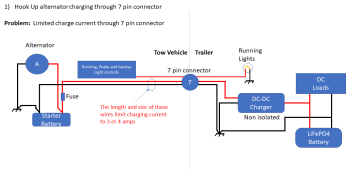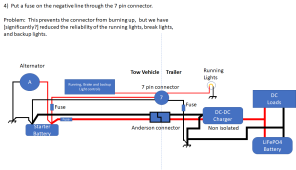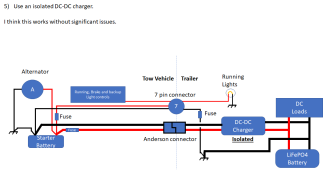FilterGuy
Solar Engineering Consultant - EG4 and Consumers
I was looking for the specs of the 7-Pin connector used for trailers and I ran accross this page.

 amsolar.com
amsolar.com
This is a problem set I had not considered before so I decided to work it through and see if I agree. Being a visual thinker, I did drawings.
EDIT/addition: There is an additional characteristic that could be more critical than anything mentioned in the diagrams below.
If there is an electrical break system that is controlled from the tow vehicle, it will not work if the chassis ground is removed from the 7 pin connector





Conclusion: Their points seem valid for non-isolated DC-DC chargers. Whether the potential issues are large enough to require the use of Isolated DC-DC converters is a judgment call each person has to make. (I have always considered Isolated chargers the best way to go for trailers, but for other reasons)
I might accept some of the risks described for a trailer I own, but I do builds and help other people that may not be as versed in all of this. Consequently, I would always advise using an isolated DC-DC charger if they want to charge from an alternator for a trailer-based system.
BTW: With the long distances from the alternator, charging from the alternator is problematic even in a full-on RV, let alone a trailer. I always encourage people to think of alternator charging as a bonus and not consider it as a primary charge source. Be happy with 20A or so of charge and don't try to pump huge currents out of the alternator.

High Current Alternator Charging | 7 Pin Connector
Because of slim wire gauges and long runs through the 7-pin connector, alternator charging to a truck camper, trailer, or 5th wheel is usually limited to no more than about 5 amps of current.
Because of slim wire gauges and long runs through the 7-pin connector, alternator charging to a truck camper, trailer, or 5th wheel is usually limited to no more than about 5 amps of current.
Bypassing this with 2/0 cable and Anderson connectors is technically possible, but it presents challenges. Both a heavy gauge negative and a positive lead need to be connected to the trailer, and the chassis connection in the 7-pin connector needs to be removed. If the 7-pin chassis connection is not removed, high current from the alternator charger may take that path and overload the wire.
The problem with modifying the 7-pin connector in this way is that the signal lights on your trailer will no longer function unless the negative high-current Anderson connection is plugged in. This could be a serious safety problem.
Because of regulations and product liability issues, this isn’t the kind of installation AM Solar will do.
This is a problem set I had not considered before so I decided to work it through and see if I agree. Being a visual thinker, I did drawings.
EDIT/addition: There is an additional characteristic that could be more critical than anything mentioned in the diagrams below.
If there is an electrical break system that is controlled from the tow vehicle, it will not work if the chassis ground is removed from the 7 pin connector





Conclusion: Their points seem valid for non-isolated DC-DC chargers. Whether the potential issues are large enough to require the use of Isolated DC-DC converters is a judgment call each person has to make. (I have always considered Isolated chargers the best way to go for trailers, but for other reasons)
I might accept some of the risks described for a trailer I own, but I do builds and help other people that may not be as versed in all of this. Consequently, I would always advise using an isolated DC-DC charger if they want to charge from an alternator for a trailer-based system.
BTW: With the long distances from the alternator, charging from the alternator is problematic even in a full-on RV, let alone a trailer. I always encourage people to think of alternator charging as a bonus and not consider it as a primary charge source. Be happy with 20A or so of charge and don't try to pump huge currents out of the alternator.
Last edited:


